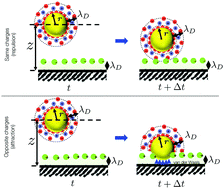Colloidal particle deposition on microchannel walls, for attractive and repulsive surface potentials†
Abstract
Surface interactions are an interplay of van der Waals adhesion forces with electrostatic charges. In colloidal deposition, at low ionic strengths, the Debye layer is sufficiently large to prevent particles from approaching the surface. It is only with the addition of higher salt concentrations, typically above 0.1 M, that surface charges are screened for interactions to take place via van der Waals-adhesion forces. This is true for repulsive charges, when both surfaces have similar charges and signs of the zeta potential are the same. However, with attractive charges, where zeta potential signs are opposite, the result is also opposite. By combining microfluidic experiments, theory, and numerical simulations, results show that when charges are attractive, particle deposition instead increases at low ionic strengths (at greater Debye lengths), at rates controlled by van der Waals forces but assisted by electrostatic forces. We propose a mechanism where particles approach the wall, mobilized by electrostatic attraction, up to a distance where van der Waals forces come into play, collecting the particles at the wall, which electrostatic forces alone are unable to achieve, owing to hindered diffusion. The present work thus allows us to understand the different mechanisms that govern deposition in the case where surface charges are opposite.



 Please wait while we load your content...
Please wait while we load your content...